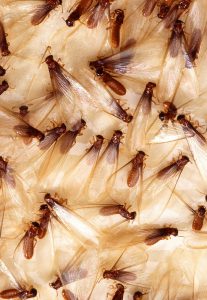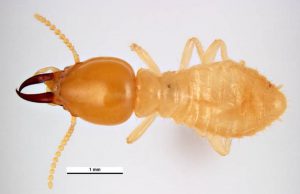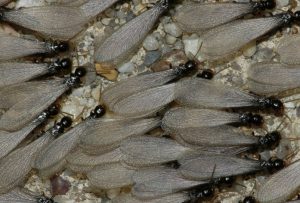Warmer seasons marks the beginning of termites swarms for homeowners in the United States. Florida’s hot and humid climate is ideal for several species of termites. In addition, our homes are at risk much earlier in the year than in other regions. Florida is home to three main types of termites: subterranean termites, dampwood termites, and drywood termites.
Subterranean termites include some of the most common and severe termite species. They are eusocial insects that live in cooperative colonies with three castes: workers, soldiers, and reproductives (also called alates or swarmers). Workers are wingless and pale, and soldiers are distinguished by an enlarged head and long mandibles. The swarmers are the only form with fully formed winged and eyes. They will fly to new locations and start new colonies.
Subterranean termites forage and form nests in soil and damp wood which is in contact with the soil. They also build mud tubes that extend from the soil up to the wood. The presence of mud tubes is a common sign of a subterranean termite infestation. Subterranean termites digest any material containing cellulose, primarily dead and decaying wood, as well as paper, cardboard, cotton fabrics, and plant fibers. There is more information on subterranean termite biology, damage, and symptoms in this EDIS publication by Wai-Han Chan et al.
The most severe subterranean termite in Florida and across the world is the Formosan subterranean termite, Coptotermes formosanus. This termite forms huge colonies, is extremely aggressive, and destroys wood at a rapid rate. Its highly destructive traits have earned it the nickname “Super Termite”. You can learn more about the Formosan termite from this EDIS publication by B. J. Cabrera et al.

Asian subterranean Termite, Coptotermes gestroi, are another severe termite pest worldwide. It shares very similar biology and life history as the Formosan termite; however, C. gestroi is primarily found in southern Florida due to its preference for tropical climates. You can read more about this species in this EDIS publication by Rudolf H. Scheffrahn and Nan-Yao Su.

The most common subterranean termites in North American belong to the genus Reticulitermes. The Eastern subterranean termite, R. flavipes, and the Western subterranean termite, R. virginicus, are found in Florida. They are not as aggressive as C. formosanus or C. gestroi, but are nonetheless significant pests in Florida. Like other subterranean termites, they nest in the soil and form mud tubes along walls so they can reach sources of wood. Read more about Reticulitermes in this EDIS publication by Nan-Yao Su and Rudolf H. Scheffrahn.

The second type of termite found in Florida is the drywood termite. As with all termites, drywood termites live in colonies with different castes. While subterranean nest in the soil, drywood termites nest entirely within the wood structures they feed on. They are typically larger than subterranean termites and have a more cylindrical shape. The presence of piles of fecal pellets accumulating beneath holes in the wood may indicate an infestation of drywood termites. In Florida, the most common species of drywood termite is the West Indian drywood termites (Cryptotermes brevis). You can read more about C. brevis in this EDIS publication by Rudolf H. Scheffrahn and Nan-Yao Su.

The third type of termite in Florida is the dampwood termite. The most common dampwood termites in Florida are in the genus Neotermes (N. castaneus, N. jouteli, and N. luykxi). Dampwood termites require high humidity, and are therefore most common in southern Florida and the Keys. Infestations of Neotermes in structural wood is typically found when there is wood-to-soil contact, or when the wood in constant contact with water, such as from leaks, free-standing water, or sprinklers. Unlike subterranean termites, dampwood termites do not forage in the soil. Neotermes are also much larger than subterranean and drywood termite species. More information on Florida dampwood termites can be found in this EDIS publication by Rudolf H. Scheffrahn and Nan-Yao Su.

Check out all these useful links on common Florida termites to learn how to monitor for mud tubes, fecal pellets, and other signs of termite infestations. If you suspect you have found termites, you can send a specimen to the UF Insect Identification Lab.
 1
1
